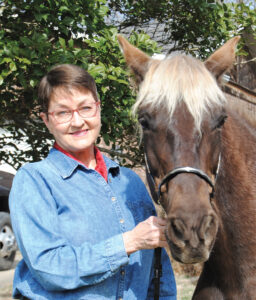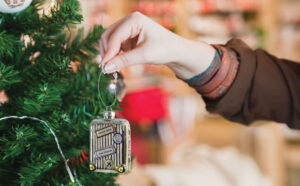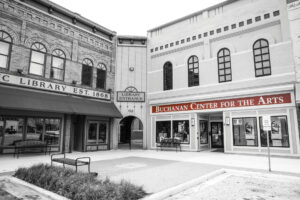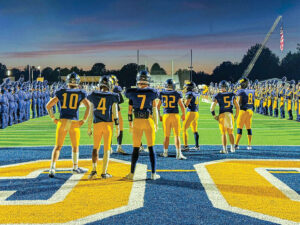The cattle Emily and Nate Gates raise near Avon, Ill., are different than the livestock on neighboring farms. The same can be said for many of the animals at Maggie and Todd Ray’s Winding Creek Farm and Stock in Argenta, outside Decatur. Likewise, there’s something special about the horses at Michael and Judy Brummer’s farm, not far from Shumway in south central Illinois.
The Gates, Rays and Brummers are among dozens of Illinois farmers and homesteaders raising heirloom breeds of agricultural livestock — animals once common across the nation, but now considered endangered.

Photo courtesy of Emily Gates
Known as heritage breeds, these are traditional livestock breeds that are a throwback to a time before industrial agriculture became a mainstream practice. According to The Livestock Conservancy, a North Carolina-based not-for-profit organization that works to promote and protect these animals, these breeds were carefully selected and bred over time to develop traits that made them well-adapted to the local environment, and they thrived under farming practices and cultural conditions that are different from those found in modern agriculture.
Because of unique characteristics (such as slower rates of weight gain, for example), these breeds fell out of favor with commercial producers, pushing some of the old breeds to the brink of extinction. Today, The Livestock Conservancy lists more than 180 agricultural breeds across 11 species on its Conservation Priority List (CPL), an annual report ranking their danger of disappearance. Breeds are classified from the most serious (“critical”) to other levels of “threatened,” “watch” and “recovering,” stepping down in severity with each classification. Based on these rankings, conservationists work to preserve these breeds.
“Our mission is to conserve the biodiversity of our farm animals,” explains Alison Martin, program director for The Livestock Conservancy. “We just want to make sure they don’t disappear from the American landscape, because the traits that they carry may have value for the unknowns in the future of farming.”
Not only do the Brummers raise heritage breed horses (in their case, Rocky Mountain horses, listed as “threatened” on the CPL), Judy serves as interim executive director of The Livestock Conservancy. A consumer-member of Shelby Electric Cooperative, she says efforts to save these breeds require a multifaceted approach.
“More than 4,000 volunteer breeders and 150-plus breed associations work diligently to ensure these endangered breeds don’t disappear from our farms, ranches and backyards throughout America,” she explains. “In addition to historical roles often tracing back more than 500 years in North America, these breeds have made important contributions to our country’s sustainable food and fiber needs of today and tomorrow.”
The protection of biodiversity and genetic resources is an important reason for protecting these breeds, Martin says, but many producers choose heritage animals because they want to make a difference. “None of us have a crystal ball to see what the future of agriculture is going to look like, and we’re already seeing changes in farming that are leading some people to bring in genetics for other breeds. It’s happened due to changes in consumer choices, and it’s happened because some of the mainstream breeds are getting narrow genetically. This is about keeping these breeds around as a genetic reservoir,” she says.

Maggie Ray says raising farm-friendly animals the old-fashioned way was attractive to her family. The Rays have a variety of animals, including American Buff geese (“watch” on the CPL), several varieties of heritage breed turkeys and Gloucestershire Old Spots pigs (listed as “threatened”).
“If we’re helping to save the planet, you might as well do it with something that needs help,” Maggie says. “Keeping these old genetics alive and reintroducing some of the benefits of them even to more commercial lines is important, things like good mothering abilities and more.”
For farmers like the Gates, consumer-members of Spoon River Electric Cooperative, the ability to find animals that would be easy to raise while “doing good” was a priority. Research on cattle breeds led the Fulton County family to Dexter cattle, a breed known as smaller-framed, multipurpose cattle, rated as “recovering” on the CPL.
“We knew we wanted a heritage breed, and we landed on the Dexters,” Emily recalls. “They seemed very docile and manageable size-wise, and they seemed like a very good fit for our family.”
The pull to heritage breeds for the Gates came from a desire to be environmentally-friendly in their farming practices. “We did a lot of education with our sons about the environment and animals and [had] conversations about why it’s important for humans to be responsible caretakers of the earth and our fellow species,” Emily explains. “It seemed an obvious choice for us to select a breed that maybe needed a little extra advocacy. If you look at the list of heritage breeds and start reading about them, they each offer such amazing traits. The diversity is wonderful.”
“We wanted a breed that didn’t need to fatten on the feed lot,” Nate adds. “We wanted animals that could selectively graze what they needed at any given time. It’s really interesting to watch them graze and see them picking and choosing different plants at different times of the year, and even selecting different parts of the plant, depending on what they know they need.”
The Gates raise many of their cattle at their ZeeLee Cattle Company on “shares,” where consumers purchase products as much as a year or two in advance.
For some, the selling point of heritage breeds is that the products from the animals are noticeably different — some would say better. Roger Schuttek of Big Muddy Hogs in the Williamson County community of Hurst raises Mulefoot and Red Wattle hogs for his direct-to-consumer pork company. He says the final products appeal to customers.
“I think because they are outside, it impacts the quality of the meat,” Schuttek explains. “The marbling — the intermuscular fat — in a Mulefoot hog is similar to a prime grade beef steak. It’s a lot more forgiving when you cook it than other pork, and it’s just a more tender, juicer meat.”
Mulefoot hogs, listed as “critical” on the CPL, are docile and intelligent, and are known for distinctive solid, uncloven hoofs. The Red Wattle pig (indicated as “threatened”) is a breed unique to North America. Red Wattle sows are excellent mothers, farrowing seven to 12 piglets per litter. Both breeds are also known for their hardiness and fare well in Illinois’ varying weather.
“These breeds are more suited to being outside in a more natural environment. They do better in the woods and on pasture and in marshy areas. They are going to graze and forage and eat a wide variety of things along with the grain they get,” Schuttek says. “That all translates into a better flavor in the meat and fat profile. It’s more buttery and such a better flavor.”
Schuttek, a consumer-member of Egyptian Electric Cooperative Association, sells his products at a weekly farmers market in Hurst.
The Rays agree that heritage breeds bring a unique flavor profile. Among their flocks are heritage breed turkeys, produced for consumers who place orders in the late spring for Thanksgiving. These birds differ from those found in grocery stores, Maggie says.
“We don’t breed for weight or size,” she says, explaining that because the turkeys are raised outside, the meat profile is different. “There’s a lot more dark meat, because these turkeys were out moving around, using muscles, and it creates flavor throughout as opposed to size. It’s like having turkey leg flavor throughout.”
Maggie says her farm also sells heritage breed pork products direct to consumers. Although it may seem counterproductive, many producers say a key to protecting heritage breeds is to consume products from these animals.
“It’s absolutely imperative that we keep raising these hogs, and, while it might not make sense on the surface, it is imperative that we eat these hogs,” Schuttek explains. “Because if you create a market for this high-quality pork from these breeds, it’s going to encourage other farms to keep these breeds, and it’ll multiply the numbers and bring them back from the verge of extinction. You have to raise these hogs and you have to eat these hogs if you want to be able to keep these hogs.”
Officials at The Livestock Conservancy refer to it as “giving these animals a job,” and the organization works to expand markets for heritage livestock products. The group is working to develop a way of connecting consumers to endangered-breed food products, and it has found success with “Shave ’Em to Save ’Em,” an effort to encourage fiber artists, weavers and spinners to discover new wools from heritage breed sheep.
The programs seem to pay off. Since first establishing the CPL 37 years ago, the organization has yet to lose a breed to extinction. In fact, in the last dozen years, 12 breeds have “graduated” off the CPL, meaning animal populations are such that the breed no longer needs continual monitoring. In 2024, two breeds — Southdown sheep and Hereford pigs — graduated from the list, and 15 breeds were reclassified within the CPL’s four tiers, most in a positive direction.

Photo courtesy of The Livestock Conservancy
For some heritage livestock enthusiasts, raising the animals are a tie to a simpler era. Judy says her research on horse breeds led her to discover that Rocky Mountain horses may have been the breed her ancestors used on their own farms generations ago. “I put value on the history of my own family, and knowing that these are likely the same kind of horses that my family enjoyed as they traveled westward many years ago is an extra plus.”
History aside, the importance of securing heritage livestock breeds is not lost on her. “Many of these once-common farm animals face extinction if we do not take action now,” Brummer adds. “Rare farm animals represent an irreplaceable piece of the Earth’s biodiversity. They offer incredible genetic diversity that may be needed in the future for disease resistance or unique production traits. Saving these breeds is vital to meeting today’s sustainability challenges and ensuring food security for the future.”
LEARN MORE
livestockconservancy.org
winding-creek-farm.com
zeeleecattleco.com
emdeemountainhorses.com
facebook.com/BigMuddyHogs









